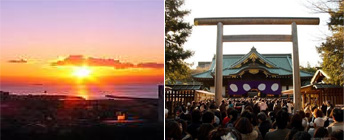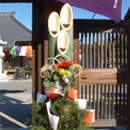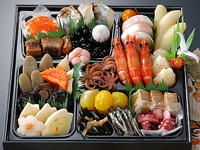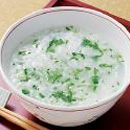Annual Events in Japan
January: Oshogatsu (New Year's Celebration)

New Year's Day on January 1st marks the beginning of a new year. This is a time for families to come together and eat foods traditionally served during the holidays. It is a day to celebrate and wish for a happy new year.
Oshogatsu was originally a festival welcoming the god known as Toshigami.
Toshigami, believed to be the god of the harvest as well as the spirits of ancestors, came to visit each home at the beginning of the year. People believed that the god would protect the harvests for the coming year and bring prosperity to families. People would purify their bodies and spirits before welcoming Toshigami. This is thought to be the beginning of Hatsumode, the traditional first visit of the year to a Shinto shrine. As an offering to Toshigami, people would prepare rice cakes and other foods. This is the origin of traditional foods served at New Year's known as Osechi.
Why are kadomatsu placed in front of homes?

During Oshogatsu, a pair of pine or bamboo New Year's decorations known as kadomatsu are placed in front of the entrance of homes. Kadomatsu serve as landmarks to ensure that Toshigami is able to visit homes without becoming lost.
What a hope is Osechi prepared with ?

Osechi is an essential part of Oshogatsu. Osechi is quite colorful and is prepared with many hopes and prayers.
For example, kazunoko is salted herring roe and symbolizes the prosperity of one's descendants. Kuromame, or black soy beans, includes the word 'mame,' which refers to 'mamemameshiku hataraku' (work diligently) meaning good health and vitality. Tasukuri, which are small sardines cooked in soy sauce, represent an abundant harvest because dried sardines were once used as fertilizer in rice fields. Konbumaki is made from seafood, such as herring, wrapped in konbu seaweed and then boiled. 'Konbu' sounds like 'yorokobu,' meaning to feel pleased or delighted, and so represents congratulations. Ebi are shrimp, and because shrimp have a 'beard' and a bent back, they represent longevity.
What are Haru no Nanakusa?

Haru no Nanakusa are 'the seven herbs of spring.' It is believed that if a person eats the seven herbs of spring on the morning of the seventh day of January, he or she will not suffer from illness for one year. The seven herbs of spring are Japanese parsley, shepherd's purse, Jersey cudweed, chickweed, Japanese nipplewort, turnip, and daikon radish.
The seven herbs of spring are highly recommended for those who may have eaten a little too much during New Year's.
The seven herbs of spring are highly recommended for those who may have eaten a little too much during New Year's.
What is Kagamibiraki?
Kagamibiraki' means 'cutting the New Year's rice cake' and is a ceremony of congratulations. On January 11th, a mirror-shaped rice cake, which is an offering to Toshigami, is cut and sweet red bean soup and other foods are eaten. In ancient times, it was believed that the spirit of Toshigami resided in the mirror-shaped rice cake. Rather than 'cut' the bond with the Toshigami, the word open (hiraku) was used instead.
We hope that Oshogatsu, when people pray for happiness in the coming new year, continues forever as a traditional Japanese event .
We hope that 2011 is a wonderful year for everyone.
We hope that 2011 is a wonderful year for everyone.





 Japan
Japan 한국어
한국어 简体字
简体字 繁体字
繁体字 English
English













